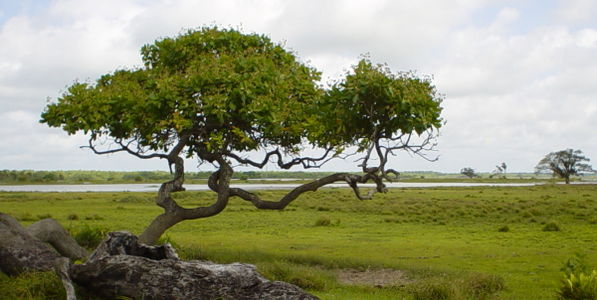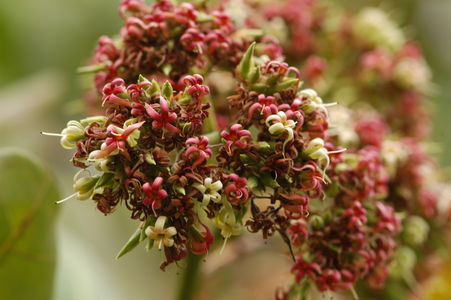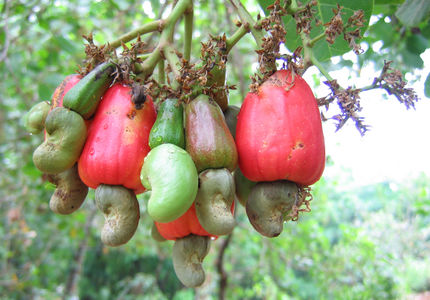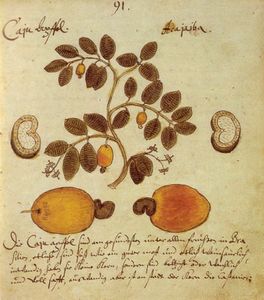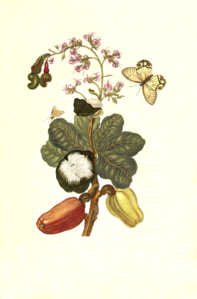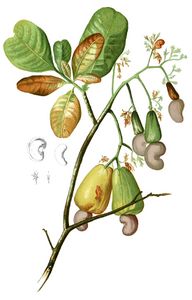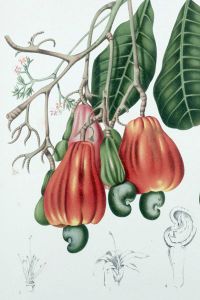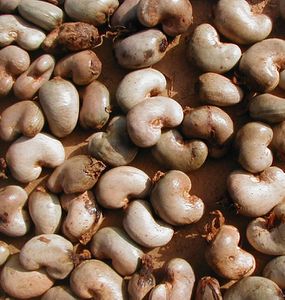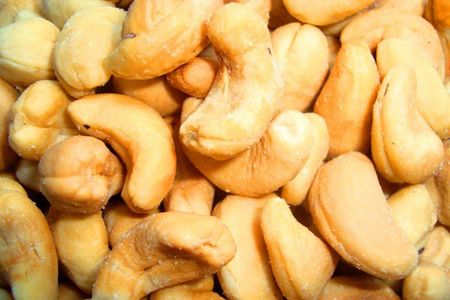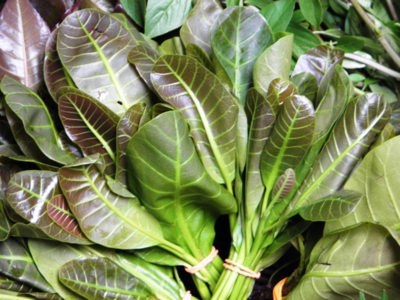Anacardium occidentale
Anacardium occidentale L.
| Ordre | Sapindales |
|---|---|
| Famille | Anacardiaceae |
| Genre | Anacardium |
2n = 42
Origine : aire d'origine
sauvage ou cultivé
| Français | anacardier / noix de cajou |
|---|---|
| Anglais | cashew / cashew nut |
- amande consommée : noix de cajou
- huile comestible extraite des amandes
- tourteau alimentaire (humains et animaux)
- pédoncule faux-fruit consommé cru, en jus,
en confiture ou en boisson : pomme cajou - baume toxique extrait des coques ou
exsudé de l'écorce, à usage industriel - médicinal : écorce, feuilles, fruits, huile d'amande
- bois d'œuvre
- planté en haies
Sommaire
Description
Noms populaires
| français | anacardier, pommier acajou / noix de cajou, noix d’acajou, anacarde / pomme cajou |
| anglais | cashew tree / cashew nut / cashew apple |
| allemand | Kaschubaum / Kaschunuß, Nierennuß / Kaschu-Apfel |
| néerlandais | cashew |
| italien | anacardio |
| espagnol | marañón, cajuil, merey |
| portugais | cajueiro / castanha de caju / caju |
| créole guyanais | cajou [kajou], pomme cajou [ponm-kajou], pommier cajou (Pharma. Guyane) |
| wayãpi | akayu (Pharma. Guyane) |
| palikur | mihitui (Pharma. Guyane) |
| aluku | kassu (Pharma. Guyane) |
- Voir l'étymologie de Anacardium
- Voir l'étymologie de acajou
Classification
Anacardium occidentale L. (1753)
Cultivars
Histoire
Acaïou Thevet 1557, 120v.
- Anacardium Clusius Exoticorum 1605 198.png
Clusius, Carolus, 1605. Exoticorum libri decem. A gauche, Anacardium officinarum (Semecarpus anacardium) ; à droite, Caious (Anacardium occidentale)
Michał Boym, 1656. Flora Sinensis
Caschou boom, planche XVI, Maria Sibylla Meriaen 1705
- Boym, Michał, 1696. Flora Sinensis. Paris, 15 p. Seconde édition en français. Voir Kia-giu sur Pl@ntUse.
Usages
Anacardium occidentale Linn. CASHEW. This tree is indigenous to the West Indies, Central America, Guiana, Peru and Brazil in all of which countries it is cultivated. The Portuguese transplanted it as early as the sixteenth century to the East Indies and Indian archipelago. Its existence on the eastern coast of Africa is of still more recent date, while neither China, Japan, or the islands of the Pacific Ocean possess it. [1] The shell of the fruit has thin layers, the intermediate one possessing an acrid, caustic oil, called cardol, which is destroyed by heat, hence the kernels are roasted before being eaten; the younger state of the kernel, however, is pronounced wholesome and delicious when fresh. Drury [2] says the kernels are edible and wholesome, abounding in sweet, milky juice and are used for imparting a flavor to Madeira wine. Ground and mixed with cocoa, they make a good chocolate. The juice of the fruit is expressed, and, when fermented, yields a pleasant wine; distilled, a spirit is drawn from the wine making a good punch. A variety of the tree is grown in Travancore, probably elsewhere, the pericarp of the nuts of which has no oil but may be chewed raw with impunity. An edible oil equal to olive oil or almond oil is procured from the nuts but it is seldom prepared, the kernels being used as a table fruit. A gum, similar to gum arabic, called cadju gum, is secreted from this tree. The thickened receptacle of the nut has an agreeable, acid flavor and is edible. [3]
Haies vives (plantations produites pour l’amande, hors Antilles). Bois petit, peu apprécié. La graine grillée est très utilisée en pâtisserie et confiserie ainsi que dans les mélanges d’amandes. L’enveloppe de la graine contient une huile caustique épaisse et noire qui sert à marquer le linge (au contact du fer) d’une manière indélébile (DUSS) ; utilisable contre les verrues et les cors, contre les termites pour préserver le bois, les livres, et d’après HONYCHURCH, utilisée pendant la deuxième guerre mondiale pour les garnitures de freins et d’isolation électrique. Feuilles en bains contre la fièvre et les rhumes ; d’après CABRE l’huile d’amande contre les dermites, eczéma, psoriasis (et contre les vers ronds d’après BRETON). Le réceptacle charnu est comestible mais astringent ; consommé en confiture aux Antilles et sert à préparer une boisson très populaire au Brésil.
Now cultivated and subspontaneous in many parts of the tropical regions. The main producers and exporters are India, Tanzania, Mocambique and Angola. There is a two-fold use of the fruits. The cashew apple is the fleshy stalk (hypocarp) of the fruit. It can be eaten ripe and serves to make jam, jelly, juice and vinegar. It is rich in vitamin C. The true fruit is the cashew or kidney nut. Its cotyledons are eaten roasted and serve in the same way as almonds. The thick pericarp contains a skin irritating poisonous oil (cashew nut shell oil), wich is of growing importance for the production of varnishes, paints, adhesives, gums, impregnations, brake linings, floor coverings and other technical products. Fruits, leaves, bark and wood are used also in the folk medicine.
Références
- Arveiller, Raymond, 1963. Contribution à l'étude des termes de voyage en français (1505-1722). Paris, d'Artrey. 571 p. Acajou, pp. 37-44.
- Chauvet, Michel, 2018. Encyclopédie des plantes alimentaires. Paris, Belin. 880 p. (p. 51)
- Grenand, Pierre, Moretti, Christian, Jacquemin, Henri & Prévost, Marie-Françoise, 2004. Pharmacopées traditionnelles en Guyane. Créoles, Wayãpi, Palikur. 2e édition revue et complétée. Paris, IRD. 816 p. (1ère éd.: 1987). Voir sur Pl@ntUse.
- Rakoto-Ratsimamanga, Albert ; Boiteau, Pierre & Mouton, Marcel, 1969. Eléments de pharmacopée malagasy. tome & (Notices 1 à 39). Tananarive, Société pour la promotion de la pharmacopée malagasy. 306 p. Voir sur Pl@ntUse
- Rollet, Bernard et coll., 2010. Arbres des Petites Antilles. Tome 1 : Introduction à la dendrologie. 276 p. Tome 2 : Description des espèces. 866 p. + 46 pl. coul. + CD de photos sur l'anatomie du bois. Basse-Terre, ONF. sur Pl@ntUse.
- TRAMIL, Pharmacopée végétale caribéenne, éd. scient. L. Germosén-Robineau. 2014. 3e éd. Santo Domingo, Canopé de Guadeloupe. 420 p. Voir sur Pl@ntUse
